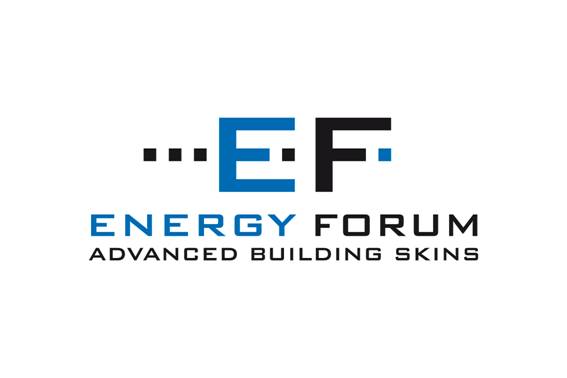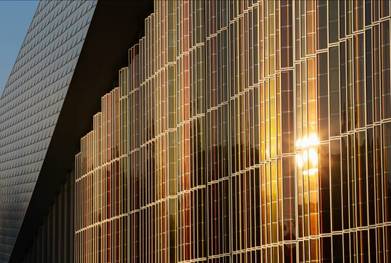Submitted by WA Contents
Conference on Advanced Building Skins
United Kingdom Architecture News - Sep 24, 2014 - 12:21 8637 views

How buildings change their skin: new Swiss ideas changing our urban scene
28-29 October 2014, Bressanone, Italy
The main objective of the conference is to contribute to a multidisciplinary, integrated planning approach to sustainable façade design, and to create a dialogue among architects, engineers, scientists, energy managers and manufacturers with the aim of reducing energy consumption while improving the comfort and health of building occupants.
28 Oct 14. Bressanone, Italy. One of the highlights of the first day of the 9th ENERGY FORUM conference on the building skins of the future (Advanced Building Skins) was the presentation of white photovoltaic modules for façades. Jordi Escarre Palou and his team from the Swiss Center for Electronics and Microtechnology CSEM in Neuchâtel presented white solar modules with efficiency levels over 10% to the 250 participants in the Bressanone conference centre in South Tyrol.
Escarre Palou says that in principle all the usual solar cells can be used for this. "We achieve the highest efficiency level through a combination of crystalline high-performance solar cells with a film treated using nanotechnology, which only filters a particular wavelength of light through to the cell and reflects the visible spectrum as a diffuse illumination," Escarre Palou explained in Bressanone on Tuesday. The result is a homogenous white solar module surface without a visible wafer structure; the module looks like a large white sheet of paper with a protective glass surface. In addition to the architectural functions, these cells can be used in the entire range of consumer goods: motor vehicles, computers, even furniture, household goods and floor tiles can carry invisible photovoltaic cells.
Simultaneous translations into Italian and English will be available for all presentations.

SwissTech Convention Centre © EPFL - Chris Blaser
White modules can help photovoltaics break through in architecture
However, the architectural aspects of the modules were the focus in Bressanone: since white modules heat up less easily, the problem of rear ventilation is reduced. In hot regions – often dominated by white buildings – these modules can be more easily integrated into the building envelope. "This technology can also be produced in many other shades such as silver or grey, as well as in various colours," said industry designer Patrick Heinstein from the PV laboratory of the EPFL in Neuchâtel, who advised the CSEM team in the development for questions of production aesthetics. The modules will already be on sale in 2015. "I find white modules very progressive," says architect René Schmid from Zürich. He welcomes the extension of the colour palette by the CSEM innovation, observing, "This is a step in the right direction that will ensure that more buildings will be equipped with photovoltaics."
Scientific Conference Committee:
- Cinzia Abbate, AeV Architetti, Rome, Italy
- Marilyne Andersen, EPFL, Switzerland
- Michael Garrison, School of Architecture, University of Texas at Austin, USA
- Hans-Martin Henning, Head of Thermal Systems and Buildings, Fraunhofer Institute for Solar Energy Systems, Germany
- Eckhart Hertzsch, Project Manager 'City of the Future', Fraunhofer Institute for Building Physics, Germany
- Andreas Karweger, General Manager, Economic Forum, Munich - Bolzano
- Dieter Moor, Ertex-Solar, Austria
- Wolfram Sparber, Director, Department of Renewable Energies, European Academy, Bolzano, Italy
- Mitsuhiro Udagawa; Department of Architecture, Kogakuin University, Japan
- Stephen Wittkopf, Technology & Architecture, Lucerne University of Applied Sciences and Arts, Switzerland
- Yigsaw Yohanis, School of the Built Environment, University of Ulster, United Kingdom

Spreitenbach environmental arena © Umweltarena
Architectural Award for building-integrated solar technology
René Schmid was awarded the Architecture Prize for building-integrated solar technology in Bressanone. This prize is awarded every three years by the Bavarian Association for the Promotion of Solar Energy for exceptional planning and design of building-integrated solar power systems. René Schmid enriched the prism-shaped roof of the Environmental Arena (Umweltarena) at Spreitenbach, near Zürich, with numerous differently-angled segments carrying photvoltaic modules. "We have used photovoltaics as a construction product in the Environmental Arena," says Schmid. The 5,400 square metre large photovoltaic modules of the futuristic solar roof generate 750 kW.
The Association for the Promotion of Solar Energy also awarded five merit prizes, of which three were also given to Swiss architects and one each to projects in Paris and Munich. The architects of Richter Dahl Rocha & Associés Architectes, Lausanne achieved an architecturally attractive integration of photovoltaics in their design of the SwissTech Convention Centre on the EPFL Lausanne Campus. The architects arranged 300 square metres of coloured cells in narrow strips of yellow, green and red shades outside the glass front of the western façade (see photograph). These do not just provide sun protection but produce delightful light effects in the foyer. "The photovoltaics are achieving four services simultaneously," says Kenneth Ross, project leader at Richter Dahl Rocha. "They implement the technology developed at the EPFL, i.e. the owner of the building; provide shade; contribute aesthetic enrichment; and generate energy as well." Further merit awards went to the Swiss architect Alex Buob for the Catholic Church in Heiden and the architect Mirlo Urbano for a single family house in Glattfelden; both projects included a solar roof.
The 10th ENERGY FORUM will be held in Switzerland
Immediately after the prize awards, the CEO of the Economic Forum and organiser of the ENERGY FORUM, Andreas Karweger, announced that one of these prize-winning buildings can be visited next year during the 10th ENERGY FORUM. For the 10th anniversary of the conference, the ENERGY FORUM will be held for the first time in Switzerland. The organisers hope to improve the accessibility of the conference with the new location in Switzerland. "A connection to international airports is very important for our participants, who are travelling from over 50 countries," says Andreas Karweger, CEO of the Economic Forum in Munich. The new location will be announced in November.
This year's topics include
Design Methods for Sustainable, High-Performance Building Facades
- The Future of Advanced Building Skin Design
- High-Tech, Low-Tech, Lightweight Building Envelopes
- Thermal Performance of Phase Change Materials for the Building Skin
- Thermal and Environmental Performance of Eco Materials for the Building Skin
- Smart Materials for Intelligent Building Envelopes
- Architectural Membranes for High Performance Building Skins
- Shading Systems for Enhanced Daylight Control
- Building Skins for Tropical Climates
- Adaptive Hortitecture: Building Envelopes as Micro Climates and Productive Environments
- Integrating Photovoltaics into the Building Envelope
- Cost Optimization for Solar Energy Systems, NZEB and Façade Renovation
- Optimization Techniques for the Refurbishment of Building Envelopes
- Building Energy Performance Simulation

Spreitenbach environmental arena © aPix Alex Buschor
Registration Fee:
The cost to participate at the ENERGY FORUM is €480 which includes all conference documentation, lunches and coffee breaks. Participants who register by 30 June will receive a 20% discount.
For the complete conference program, please visit our website at www.energy-forum.com
The conference fee is 480 EUR and includes the proceedings (full manuscripts) and two lunches.
Please click on PDF
For more information please visit website
> via energy-forum.com